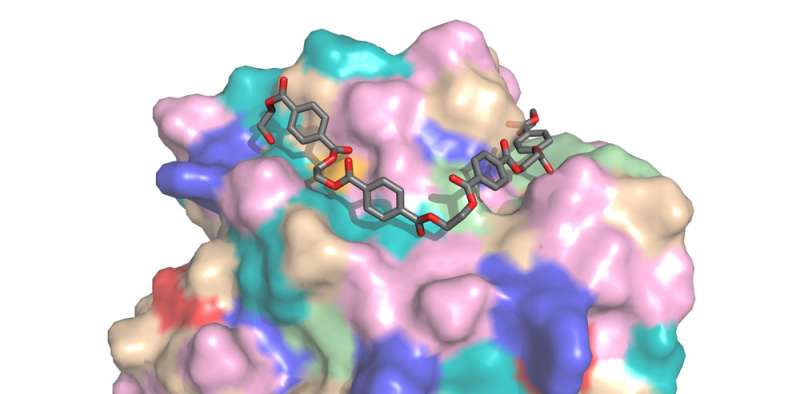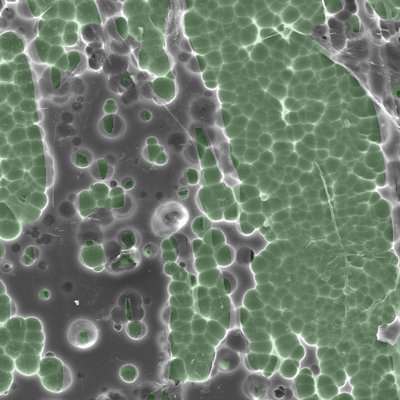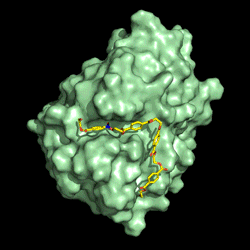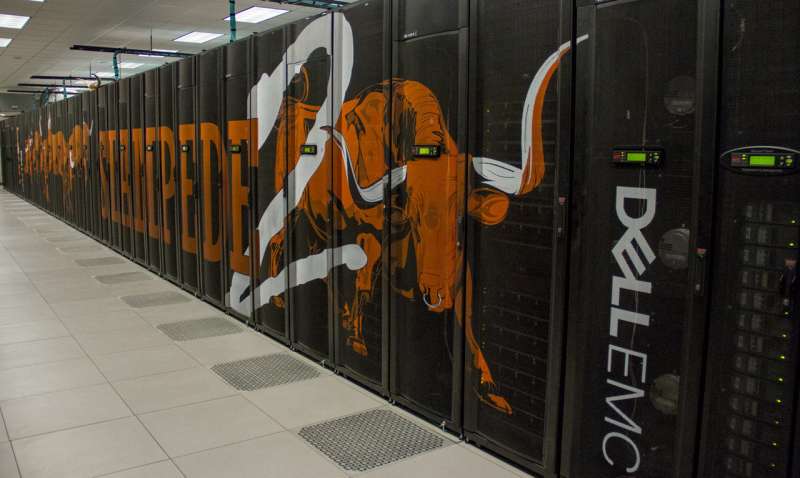Supercomputers help design mutant enzyme that eats plastic bottles

A dump truck's worth of plastic empties into the ocean every minute. Worldwide, humankind produces over 300 million tons of plastic each year, much of which is predicted to last centuries to millennia and pollutes both aquatic and terrestrial environments. PET plastic, short for polyethylene terephthalate, is the fourth most-produced plastic and is used to make things like beverage bottles and carpets, the latter essentially not being recycled. Some scientists are hoping to change that, using supercomputers to engineer an enzyme that breaks down PET. They say it's a step on a long road toward recycling PET and other plastics into commercially valuable materials at industrial scale.
"We're ideally going from a place where plastics are hard to recycle to a place where we use nature and millions of years of evolution to direct things in a way that make plastic easy to recycle," said Lee Woodcock, an Associate Professor of Chemistry at the University of South Florida. Woodcock co-authored a study that studied the structure of an enzyme to degrade PET and was published March of 2018 in the Proceedings of the National Academy of Sciences.
The study builds on a discovery in 2016 by Yoshida et al. of a bacterium, Ideonella sakaiensis 201-F6, that feeds on PET plastic as its source of carbon and energy. The PNAS study authors focused on the bacteria's plastic-degrading enzyme, called PETase. Team members at the University of Portsmouth, led by Professor John McGeehan, used X-ray crystallography at the Diamond Light Source in the UK to solve the high resolution crystal structure of PETase.
"We then used computer simulations to understand how a polymeric ligand like PET would be able to bind to the enzyme," said study co-author Gregg Beckham, a Senior Research Fellow and Group Leader at the US National Renewable Energy Laboratory (NREL). "We also conducted experimental work to show that indeed, the PETase can break down water or soda bottles, industrially relevant PET films, and another plastic, polyethylene furanoate."
After doing this work on the structure and function of the PETase enzyme, the authors next tried to understand its evolution and look to a similar enzyme, a family of cutinases, which degrade the waxy polymer cutin found on the surface of plants.

"We developed the hypothesis that if we make the PETase enzyme more like a cutinase, then we should make the enzyme worse. When we did this work, in fact we ended up making the enzyme slightly better by doing that," Woodcock said.
"It was incredibly surprising to us," Beckham explained. "When we made it more cutinase-like, the enzyme was modestly improved. That's actually one of the key aspects of where computation came in, because it allowed us to essentially predict or suggest aromatic-aromatic interactions in the enzyme with the aromatic polyester PET could potentially be responsible for its improved activity. But it was quite a surprise to us," Beckham said.
Supercomputers allowed them to tackle tough science questions on PETase, such as the details of how it interacts on a molecular scale bound to a substrate, something beyond the scope of what could be determined by knowing its crystal structure.
The researchers took advantage for this study of computational resources of XSEDE, the Extreme Science and Engineering Discovery Environment, funded by the National Science Foundation.
"Having access to XSEDE resources really opens up the possibility of being able to model and being able to study what type of large-scale conformational or even local, small structural changes occur as a function of both binding to the substrate and, additionally, what are the structural changes the large-scale or local, small scale structural changes that occur in the enzyme after we make the mutations. That was a big part of what we were looking at," Woodcock said.

Woodcock explained that they simulated the long timescales of the enzyme using the Chemistry at Harvard Macromolecular Mechanics (CHARMM) force field and program itself, as well as Nanoscale Molecular Dynamics (NAMD) software.
XSEDE awarded Gregg Beckham allocations on the Stampede1 and Stampede2 systems at the Texas Advanced Computing Center (TACC) and on the Comet system at the San Diego Supercomputer Center (SDSC).
"Our experience to date on Stampede2 has been absolutely wonderful," Beckham said. "For all the codes on there that we use, it's been a fantastic machine. We get through the queues quickly. We're producing a lot of great science across the spectrum of what our groups are collectively doing together using Stampede2 right now. Certainly, for the research on the plastics-degrading enzyme, we're using it for manuscripts and studies going forward on this same topic."
"One nice thing about Comet," Woodcock said, "is that you have, for jobs that you need to get through in a high-throughput fashion, SDSC has a shared queue, which allows you to submit much smaller jobs but do it in a very high-throughput fashion, as they can share cores on the nodes at Comet. This was particularly helpful."
Both researchers agreed that computation helps make scientific discoveries. "Experimentalists and computational scientists are working hand-in-hand ever more frequently," Woodcock said. "And without access to resources like this, this would really take us a step back, or multiple steps back in producing the highest levels of science and really being able to address the world's most challenging problems, which is what we did in this particular study, done by partnering with top level experimental groups like our collaborators in the UK and with us here in the US."

Beckham said that their work has just begun on enzymes that clean up plastic pollution. "We're just starting to understand how this enzyme has evolved," Beckham said. He wants to use computation to take advantage of large databases of genomics and metagenomics on enzymes to find the needles in the haystack that can degrade plastics.
"The other thing too that we're interested in," Beckham said, "is if we're able to do this at much higher temperature, that would be able to accelerate the degradation of PET and get us into realms that potentially could be industrially relevant in terms of using an enzyme to degrade PET and then convert that into the higher value materials, which could incentivize higher rates of reclamation, especially in the developing world where lots of plastic waste goes into the ocean."
Lee Woodcock sees new computational techniques as a game-changer in modeling non-druglike forcefields that tackle polymer interactions more realistically than CHARMM and NAMD can today. "I'm working with colleagues at NREL on making sure that we can improve the force fields in a very rapid fashion, so that if somebody comes in and says that we need to look at this polymer next, we have confidence that we can put together a modeling strategy in a very short amount of time to get that a quick turnaround when we have to model many different polymers.
The scientists are hopeful their work will one day make the world outside of the lab a better place. "Understanding how we can better design processes to recycle plastics and reclaim them is a dire global problem and it's something that the scientific and engineering community has to come up with solutions for," Beckham said.
The study, "Characterization and engineering of a plastic-degrading aromatic polyesterase," was published in March 2018 in the Proceedings of the National Academy of Sciences. The authors are Harry P. Austin, Mark D. Allen, Alan W. Thorne, John E. McGeehan of the University of Portsmouth; Bryon S. Donohoe, Rodrigo L. Silveira, Michael F. Crowley, Antonella Amore, Nicholas A. Rorrer, Graham Dominic, William E. Michener, Christopher W. Johnson, Gregg T. Beckham of the National Renewable Energy Laboratory; Fiona L. Kearns, Benjamin C. Pollard, H. Lee Woodcock of the University of South Florida; Munir S. Skaf of the University of Campinas; Ramona Duman,Kamel El Omari, Vitaliy Mykhaylyk, Armin Wagner of the Diamond Light Source, Harwell Science and Innovation Campus. The National Renewable Energy Laboratory Directed Research and Development Program funded the study, with computer time provided by the Extreme Science and Engineering Discovery Environment (XSEDE) allocation MCB-090159.
More information: Harry P. Austin et al. Characterization and engineering of a plastic-degrading aromatic polyesterase, Proceedings of the National Academy of Sciences (2018). DOI: 10.1073/pnas.1718804115
Journal information: Proceedings of the National Academy of Sciences
Provided by Texas Advanced Computing Center





















